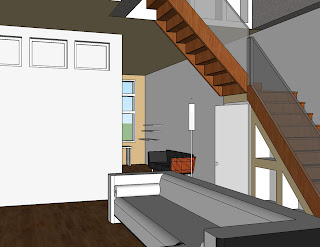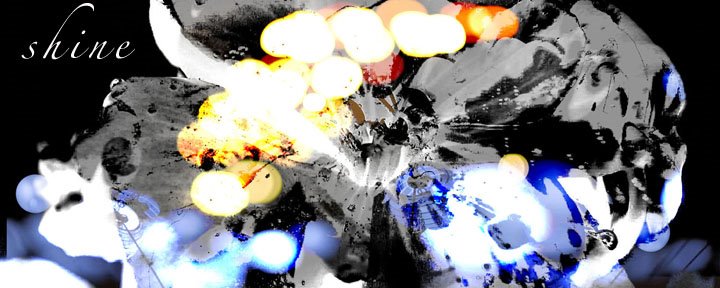
Thursday, May 7, 2009
Saturday, May 2, 2009
Hipster Haven - 3 is Company
 Front View
Front View Section South Wall
Section South Wall Elevation East Wall
Elevation East Wall
Plan Main Floor and Loft
 View of Loft from Stair
View of Loft from Stair View from Kitchen
View from Kitchen Office in rear of space
Office in rear of space View from the Entrance
View from the Entrance Bathroom
Bathroom View of Kitchen and Entrance from Stair
View of Kitchen and Entrance from StairMy space is based on the power of 3. This concept lead me in shaping my space. I grouped my windows, cabinets, and walls in 3. I pushed and pulled the space in reaction to the number 3. I really enjoyed this project and shaping this space.
Monday, April 27, 2009
Thursday, April 9, 2009
Thursday, April 2, 2009
Monday, March 23, 2009
Pattern Perception
Friday, March 6, 2009
Spa in the Raw...
This place to bathe has finally come full circle. I started out researching the Roman baths and attempted using their 3 main rooms as the basis behind my spa, upon more research I was really intrigued by the Native American sweat lodges. Not only did they use the sweat lodges as places to bathe, the Native Americans thought of their time inside the lodge as a time of purification, ridding themselves of all impurities to get back to the 'natural' self. My design took a turn in the direction. I wanted to create a place to bathe that was as raw as the Native American sweat lodges. The original lodges were all very low to the ground basic domed structures; made out of saplings and animal hides. In accordance to ADA requirements height had to be adjusted just enough for a wheelchair to enter the space. Over all the space is 7'-0" tall and 13'-0" wide. I enclosed the circle in the square to help with the requirements for users with disabilities and because I wanted the lodge to connect back to the original form. Instead of having a hole in the ground in the center of the space like the Native Americans, there is a 3'-0" tall shelf that is 8" wide circling around the space where the heated stones would be placed.
The exterior walls are concrete substrate with a stucco finish. The beams on the outside of the structure are oak. The interior walls are concrete substrate with a layer of applied stucco and the top half of the wall has teak wood panelling. The floor is a concrete slab with teak wood on top. and the ceiling piece is reinforced concrete, with double pane glass in the 4" gap between it and the oak posts.
Wednesday, February 25, 2009
Spa in the Raw...
In researching spas, places to bathe, and the different implications of bathing, a few things continued to repeat themselves. Bathing was a socially accepted public occurrence in most cultures. The bathhouse or baths were places for socialization and equality; everyone could take part no matter color, free or slave, and male or female. It was a time for relaxation and enjoying oneself. The cleansing that took part at the baths was looked at by most as an opportunity to clean and renew the body. Water was looked at as a source of healing. Many would soak in the water for 10-11 hours at a time in "special" springs or anointed baths because those water had been deemed worthy of certain healing powers.
Monday, February 23, 2009
Place to Dine: Transitions









 The concept behind this dining space was Transitions or Transitioning. I started with the table. It is a 20' wood table, with inlaid wood triangles and as you progress down the table to the buffet the triangles get bigger and push up from the table to create a buffet or place to serve food from. The chair I chose to put with this table is a modernized version of the Rietveld Z chair in a white leather with chrome legs. The room reflects the reactions of the triangles pushing out. The walls tilt in and out creating a dynamic space. Due to the tilting of the walls, the ceiling intersects itself and creates breaks to allow natural light in the room. The ceiling at its highest is 13'. There are hanging lights from the ceiling casting light only on the table. The East elevation depicts the ay window created by the tilted walls. The walls and ceiling are concrete substrate with sheet rock applied and finished with paint. The floor is polished concrete.
The concept behind this dining space was Transitions or Transitioning. I started with the table. It is a 20' wood table, with inlaid wood triangles and as you progress down the table to the buffet the triangles get bigger and push up from the table to create a buffet or place to serve food from. The chair I chose to put with this table is a modernized version of the Rietveld Z chair in a white leather with chrome legs. The room reflects the reactions of the triangles pushing out. The walls tilt in and out creating a dynamic space. Due to the tilting of the walls, the ceiling intersects itself and creates breaks to allow natural light in the room. The ceiling at its highest is 13'. There are hanging lights from the ceiling casting light only on the table. The East elevation depicts the ay window created by the tilted walls. The walls and ceiling are concrete substrate with sheet rock applied and finished with paint. The floor is polished concrete.
Thursday, February 5, 2009
Wednesday, January 28, 2009
Monday, January 26, 2009
Computing in Architecural Design
Computing in design today is helpful not only to clients but to designers as well. Although some programs tend to have their own quirks and learning curves each has its advantages in the field. From talking to top designers and architects, computer aided design has made their jobs easier and more time efficient. Computing in design used to be just using a calculator to help with measurements and conversions, now we can create rooms with textures and do virtual tours of the hypothetical space designed in the computer. It is truly amazing how the technology has changed and enhanced the designers experience in the field.
To me, computing in design is a little intimidating but once you have mastered it, it is a very valuable skill to have. With that said, being able to create awesome virtual spaces with the new programs is now practically a required skill across the field but I feel like designers still need to be able to create spaces and communicate without the computer as well. The increasing technology is a great advantage to the world of design because both clients and designers alike can get a better 3 dimensional idea of the design with opportunities for change and fixing problems before the actual product is begun.
We are quickly heading toward a completely digital world. Ever since the first gigantic computer, technology has bee a huge asset to not only design but the world entirely. As we move closer toward digital entirety, the fundamentals should not be forgotten. Technology is great and an amazing tool, but a good designer should be able to communicate their ideas without computer aid as well as with its help.
To me, computing in design is a little intimidating but once you have mastered it, it is a very valuable skill to have. With that said, being able to create awesome virtual spaces with the new programs is now practically a required skill across the field but I feel like designers still need to be able to create spaces and communicate without the computer as well. The increasing technology is a great advantage to the world of design because both clients and designers alike can get a better 3 dimensional idea of the design with opportunities for change and fixing problems before the actual product is begun.
We are quickly heading toward a completely digital world. Ever since the first gigantic computer, technology has bee a huge asset to not only design but the world entirely. As we move closer toward digital entirety, the fundamentals should not be forgotten. Technology is great and an amazing tool, but a good designer should be able to communicate their ideas without computer aid as well as with its help.
Subscribe to:
Posts (Atom)













